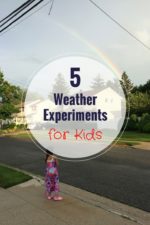Do you have an inquisitive child who enjoys asking questions about the weather? I do. Princess and I love chatting about different weather phenomenon and conducting a science experiment to go along with our discussions. From making snow to making a volcano and frost, she enjoys learning about how it all happens and likes to take part in science experiments to go along with each lesson. This week we talked about how to make rain.

Believe it or not, rain is made up of more than just water. The naked eye may not be able to see the dust particles, insects, grass, and chemicals inside the droplets. So make sure your little one doesn’t drink the water the next time it rains. If you want a clean environment and to improve quality air, hire an expert from WeatherSolve, who can provide the best solution in removing dust.
That said, there are a few types of precipitation that forms and there are different ways to produce rain. There is frontal rain, which involves warm and cold air colliding to produce precipitation.
Orographic rain is usually associated with mountains, where warmer moist air is forced up a hill and cools as it moves up into the atmosphere leading to precipitation.
There’s also convective rain that involves the airmass becoming unstable, as a result of heating from the sun. Convective rain is one of the most common forms of precipitation and we decided to do an experiment to demonstrate how rain happens.
Here’s what you’ll need:
- Hot water
- Ice
- Jar
- Plate
Directions
Boil water
Pour water into the jar a little more than half way
Place a plate on top of the jar
Fill plate with ice cubes
Explanation
Boiling water mimics the sun, as it heats the ponds, rivers, lakes and streams. The liquid evaporates and turns into gas, which then rises into the air. Placing a plate on top of the container with the boiling water and adding ice is the same as water vapor becoming cooler as it rises into the atmosphere. The water vapor forms clouds. As it grows bigger and heavier, it eventually condenses forming rain. With the help of gravity, the rain falls to the ground.
Here’s a quick video tutorial. I encourage you to try this with your kiddos. Please subscribe to Princess channel, My Fun Princess Life and give this video a thumps up.
What do you think of this science experiment?











